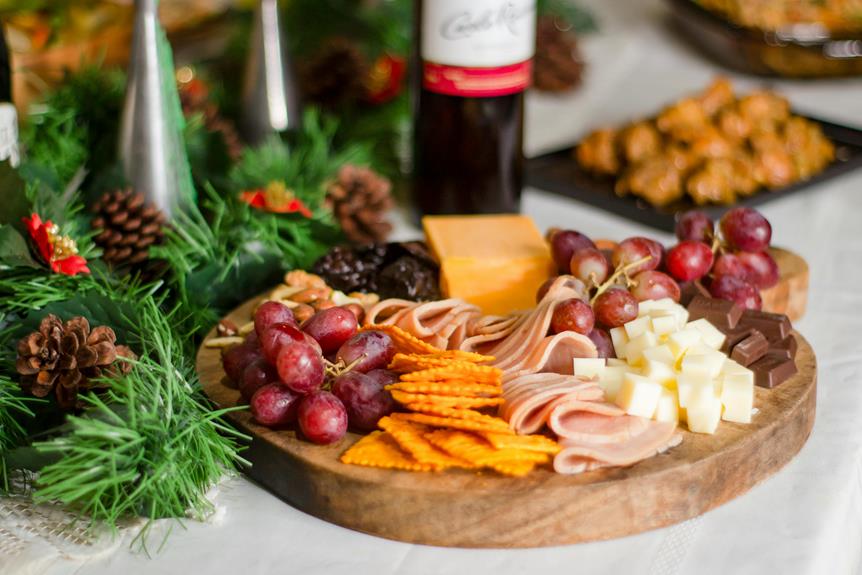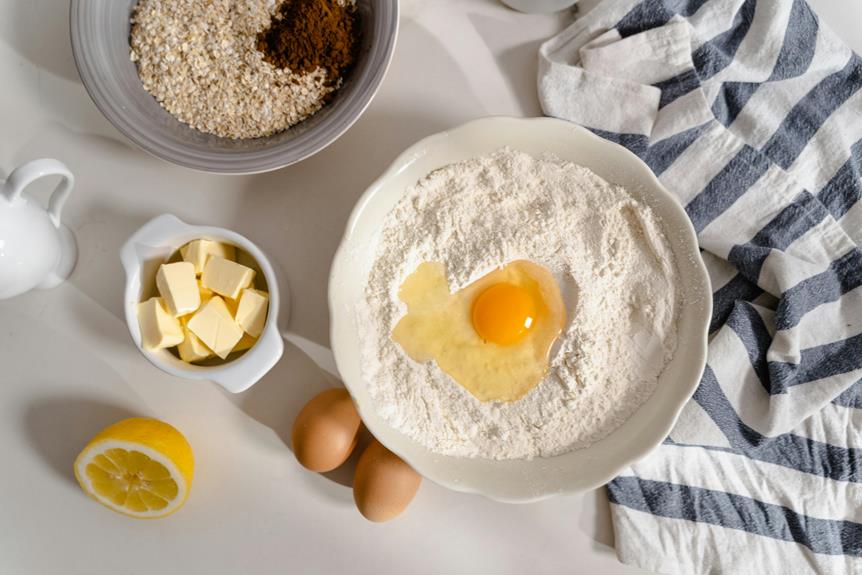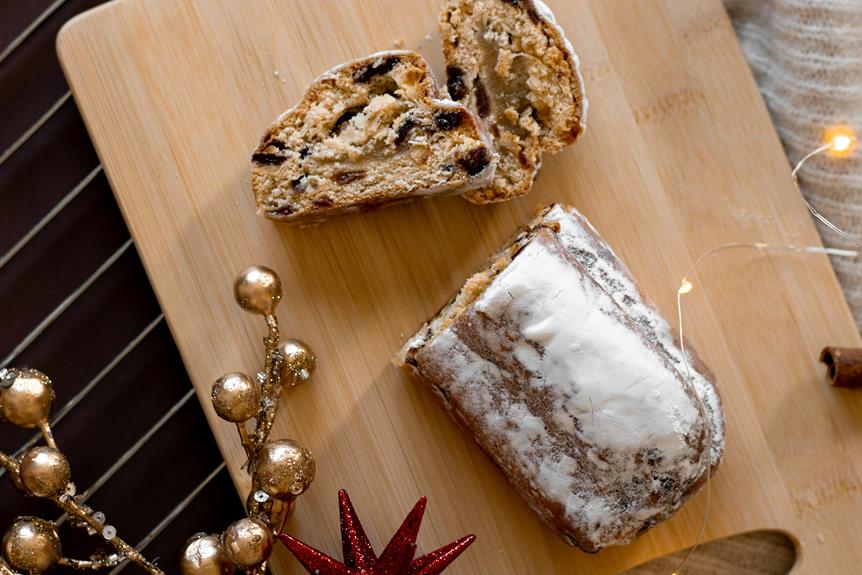You're on a mission to create a show-stopping Christmas ham that will impress your friends and family. Start by selecting a high-quality ham, considering factors like country of origin and meat labels. Prepare the ham by removing packaging, trimming excess fat, and scoring the surface. Choose a glaze that suits your taste, from fruity to spicy, and apply it during the last 30 minutes of baking. Master cooking techniques like oven-roasting, grilling, or pan-frying, and don't forget to pair your ham with sweet and tangy accompaniments. Now, take the next step towards creating a truly unforgettable festive centerpiece.
Key Takeaways
- Consider the country or region of origin and curing method when selecting a ham to ensure the desired flavor and quality.
- Remove packaging and netting, trim excess fat, and score the surface to facilitate glaze penetration and promote a crispy texture.
- Choose a glaze that complements the ham's flavor profile, such as fruit syrups, spicy drizzles, or traditional glazes like brown sugar-mustard.
- Cook the ham to an internal temperature of 140°F (60°C) and use a meat thermometer to verify, avoiding overcooking and ensuring food safety.
- Pair the ham with sweet and tangy accompaniments, such as pineapple or orange slices, and garnish with fresh herbs for a stunning presentation.
Choosing the Perfect Ham Cut
When selecting a Christmas ham, you'll be faced with a variety of cuts to choose from, each with its own unique characteristics and benefits.
You might find yourself wondering what sets them apart. One key factor to weigh is the ham's origin. Look for labels indicating the country or region of origin, as this can impact the flavor and quality of the ham.
For example, Italian prosciutto-style hams are often cured for a longer period, giving them a more intense flavor.
Meat labels can also provide valuable information. Check for labels like 'bone-in' or 'boneless' to determine the ham's texture and ease of carving.
You might also see labels indicating the level of sodium or added preservatives. If you're looking for a more natural option, opt for a ham with fewer additives.
Additionally, think about the ham's glaze or coating – some may be pre-glazed, while others may require you to add your own.
Preparing the Ham for Glazing
Now that you've selected the perfect ham cut, it's time to prepare it for glazing. This vital step guarantees your ham absorbs the glaze evenly and caramelizes beautifully.
Start by removing any packaging and netting from the ham. If your ham has a thick layer of fat, you may want to trim it slightly to promote better glazing.
Next, focus on the Ham Score – the diamond pattern of cuts on the ham's surface. Use a sharp knife to deepen the score, being careful not to cut too deeply into the meat. This will help the glaze penetrate the ham and create a sticky, caramelized crust. For a more intense flavor, you can also score the fat layer underneath the skin.
Proper Meat Prep is essential for a successful glaze. Pat the ham dry with paper towels to remove excess moisture, which will facilitate the glaze's adhesion. If your ham has a skin, you can leave it on or remove it, depending on your preference.
With your ham prepared, you're now ready to move on to the fun part – choosing a glaze that will make your Christmas ham truly unforgettable.
Glaze Options and Recipes
You have numerous glaze options to choose from, each offering a unique flavor profile to elevate your Christmas ham.
From sweet and sticky to spicy and savory, the possibilities are endless. Fruit syrups, such as pineapple or cherry, add a fruity twist to your ham, while spicy drizzles, like a habanero-honey glaze, will give it a bold kick.
If you prefer a more traditional approach, a brown sugar-mustard glaze or a honey-bourbon glaze are always crowd-pleasers.
You can also experiment with different spices and herbs to create a custom glaze that suits your taste.
For a sweet and savory glaze, try combining maple syrup, Dijon mustard, and thyme. If you want to add a bit of heat, mix together honey, chipotle peppers, and garlic.
Whatever glaze you choose, make sure to brush it on during the last 30 minutes of baking to achieve a sticky, caramelized crust.
With so many options to choose from, you're sure to find the perfect glaze to make your Christmas ham a showstopper.
Curing and Smoking Methods
Take your Christmas ham to the next level by exploring the art of curing and smoking, techniques that can add incredible depth and complexity to its flavor profile.
Curing involves using salt to draw out moisture and preserve the meat, while smoking infuses a rich, savory flavor.
You can try salt brining, a wet-curing method that involves soaking the ham in a saltwater solution, or use a dry cure with a mixture of salt, sugar, and spices.
When it comes to smoking, wood selection is vital. Different types of wood, such as hickory, applewood, or cherry, will impart unique flavors to your ham.
You can use a smoker or even your grill to achieve that perfect smoky flavor. Remember to keep the temperature low and the smoke steady to prevent the ham from drying out.
With curing and smoking, you'll be able to create a truly show-stopping Christmas ham that's sure to impress your guests.
Oven-Roasted Ham Techniques
By skipping the curing and smoking process, you can still achieve a deliciously flavorful Christmas ham using oven-roasted techniques that require minimal preparation and equipment.
One key to success is maintaining a consistent oven temperature, which facilitates even cooking and prevents overcooking. Preheat your oven to 325°F (160°C), and place the ham on a rack in a roasting pan. Score the fat in a diamond pattern, cutting about 1/4 inch deep, to allow the glaze to penetrate.
To keep the ham moist, baste it every 20-30 minutes with a mixture of brown sugar, mustard, and spices. You can also use a glaze made with honey, maple syrup, or fruit preserves for added flavor.
Use an internal thermometer to check the ham's internal temperature, aiming for 140°F (60°C). Once it reaches this temperature, remove it from the oven and let it rest for 15-20 minutes before slicing and serving.
With these simple oven-roasted techniques, you'll be enjoying a mouthwatering Christmas ham in no time!
Grilling and Pan-Frying Options
A sizzling grill or hot skillet can add a caramelized crust to your Christmas ham, amplifying its flavor and texture.
When grilling, you'll achieve a smoky, charred flavor profile that pairs perfectly with sweet or spicy glazes. To grill your ham, preheat your grill to medium-high heat, then sear the ham for 2-3 minutes per side, or until it develops a nice crust. Finish cooking the ham in a cooler part of the grill, covering it with foil to prevent overcooking.
Pan-frying offers a crispy, golden-brown crust and a rich, savory flavor. Searing techniques are key to achieving the perfect crust. Heat a skillet over high heat, then add a small amount of oil. Sear the ham for 2-3 minutes per side, or until it develops a nice crust.
Finish cooking the ham in the oven, covering it with foil to prevent overcooking. Both grilling and pan-frying offer unique flavor profiles and textures, so experiment with different techniques to find your favorite. Just remember to adjust cooking times and temperatures based on the size and type of your ham.
Ham Pairing and Garnish Ideas
Transforming your Christmas ham into a show-stopping centerpiece is as easy as pairing it with complementary flavors and garnishes that elevate its natural richness.
You can create a stunning presentation by pairing your ham with sweet and tangy fruit accompaniments, such as pineapple rings, cherry halves, or orange slices. These sweet and savory combinations will balance out the saltiness of the ham, creating a delightful flavor experience.
To add an extra layer of elegance, consider creating a herb crown to adorn your ham.
Simply gather a few sprigs of fresh rosemary, thyme, or parsley, and arrange them into a small bouquet. You can tie the stems together with kitchen twine or a small wire to create a charming centerpiece.
This herb crown won't only add a pop of color but also infuse the ham with aromatic flavors.
Timing and Temperature Control
As you've carefully considered the visual appeal of your Christmas ham, it's now time to focus on the behind-the-scenes work of timing and temperature control to guarantee your ham is cooked to perfection.
To achieve this, you'll need to master two vital elements: defrosting strategies and cooking rhythms.
Defrosting Strategies: Allow plenty of time for your ham to thaw safely in the refrigerator, or use the cold water method for a quicker thaw. Never thaw at room temperature, as bacteria can grow rapidly.
Temperature Control: Preheat your oven to the recommended temperature (usually around 325°F). Use a meat thermometer to verify the ham reaches an internal temperature of at least 140°F.
Cooking Rhythms: Plan your cooking schedule in advance, allowing about 20 minutes per pound of ham. You can also use a cooking chart to guide you.
Monitoring Progress: Regularly check the ham's temperature and adjust the cooking time as needed. This will confirm your ham is cooked to perfection and safe to serve.
Common Ham Cooking Mistakes
Your Christmas ham is only as good as the mistakes you avoid, and one of the most common pitfalls is overcooking, which can leave your ham dry and flavorless. You risk turning a juicy, tender ham into a tough, unappetizing centerpiece.
To avoid overcooking, make sure you're checking the internal temperature regularly, and don't be afraid to use a thermometer to verify it reaches a safe minimum internal temperature of 140°F.
Another mistake to watch out for is ham neglect. It's easy to get distracted during the holiday rush, but forgetting to baste your ham or failing to rotate it in the oven can lead to uneven cooking and a less-than-impressive presentation.
Set a timer to remind yourself to baste and rotate your ham every 20-30 minutes to guarantee even glazing and a beautiful, caramelized crust.
Presentation and Serving Tips
Finishing touches can elevate your Christmas ham from a humble main course to a stunning holiday showstopper. You've put in the effort to cook the perfect ham, now it's time to make it visually appealing. A beautifully presented ham can be the centerpiece of your holiday table.
Garnish Ideas: Add a sprig of fresh rosemary, a few cranberries, or a slice of orange to give your ham a pop of color and fragrance.
Fancy Slicing: Slice your ham thinly against the grain and arrange the slices in a decorative pattern on the platter.
Elegant Tablescapes: Create a festive tablescape by adding candles, pinecones, and evergreen branches around the ham platter.
Serve with Flair: Serve your ham with a side of warm biscuits, sweet potato casserole, or a fresh green salad to round out the meal.
Frequently Asked Questions
Can I Use a Spiral-Cut Ham for a More Even Glaze Application?
You're wondering if a spiral-cut ham is the way to go for a more even glaze application? Yes, it's a great choice, as the cuts allow for better ham presentation and more uniform glaze distribution, making your holiday ham truly shine!
How Do I Store Leftover Christmas Ham to Maintain Freshness?
You'll want to store leftover Christmas ham in airtight ham containers, wrapped tightly in fresh wraps, like plastic wrap or aluminum foil, to maintain freshness for up to 5 days in the fridge or 2 months in the freezer.
Are There Any Ham Preparation Methods Safe for Pregnant Women?
When you're pregnant, it's essential to prioritize pregnancy nutrition and food safety. You can safely enjoy ham if it's heated to an internal temperature of 165°F (74°C), ensuring the kill of harmful bacteria like Listeria and Salmonella.
Can I Serve Christmas Ham at Room Temperature Safely?
You're tempted to leave that savory Christmas ham at room temperature, but don't! Food safety experts warn that bacteria grow rapidly between 40°F and 140°F, so keep it refrigerated or use proper temperature control to guarantee a safe and delicious feast.
How Long Can I Keep a Glazed Ham at Room Temperature?
When you're wondering how long to keep a glazed ham at room temperature, remember that Food Safety guidelines advise against leaving it out for more than two hours, as this can compromise Ham Quality and lead to foodborne illness.
Conclusion
You've made it to the finish line, and your festive Christmas ham is ready to shine!
Like a symphony conductor, you've orchestrated a harmonious blend of flavors, textures, and presentation.
As you slice into the juicy, caramelized goodness, the aroma wafts up, a sweet serenade to your senses.
Your guests will be green with envy, and your Christmas celebration will be the talk of the town.
Now, go ahead, take a bow, and bask in the glory of your culinary masterpiece!


